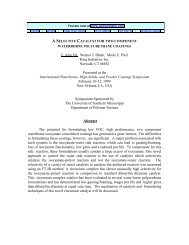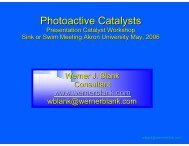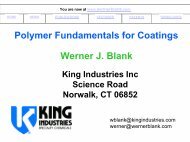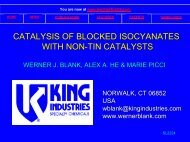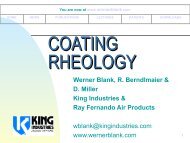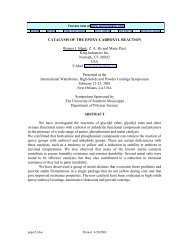Catalysis of the Isocyanate-Hydroxyl Reactions ... - Wernerblank.com
Catalysis of the Isocyanate-Hydroxyl Reactions ... - Wernerblank.com
Catalysis of the Isocyanate-Hydroxyl Reactions ... - Wernerblank.com
You also want an ePaper? Increase the reach of your titles
YUMPU automatically turns print PDFs into web optimized ePapers that Google loves.
<strong>the</strong> Zr tetrakis(2,4-pentanedionato) <strong>com</strong>plex. It is interesting to note that some <strong>of</strong> <strong>the</strong> metal<br />
<strong>com</strong>pounds are more catalytic as <strong>the</strong> carboxylate salts where o<strong>the</strong>rs are more reactive as <strong>the</strong><br />
pentanedionate <strong>com</strong>plex.<br />
Because <strong>of</strong> <strong>the</strong> high catalytic activity <strong>of</strong> <strong>the</strong> zirconium tetrakis(2,4-pentanedionato) <strong>com</strong>plex we<br />
decided to fur<strong>the</strong>r investigate its catalytic activity.<br />
Potlife and tack-free time <strong>of</strong> polyester/HDI-trimer uncatalyzed and with DBTDL, ZrAcAc<br />
catalyzed formulations 21 was determined. (Figure 2). Although <strong>the</strong> formulation containing <strong>the</strong><br />
ZrAcAc catalyst has a substantially shorter potlife that <strong>the</strong> DBTDL catalyzed system, <strong>the</strong> tack-free<br />
time was significantly larger, raising <strong>the</strong> question about potential deactivation <strong>of</strong> <strong>the</strong> catalyst in <strong>the</strong><br />
presence <strong>of</strong> moisture.<br />
NO CATALYST<br />
Al DIONATE<br />
Ce NAPHT<br />
Ti ACETAC<br />
Zn ACET<br />
Zn DIONATE<br />
Bi OCT.<br />
Zn OCT.<br />
Ti DIONATE<br />
Mn DIONATE<br />
Ni DIONATE<br />
Co OCT.<br />
Co DIONATE<br />
Zr DIONATE<br />
DBTDAc<br />
DBTDL<br />
0 100 200 300 400 500 600<br />
GEL TIME, MINUTES<br />
Figure 1 Acrylic Polyol/HDI-trimer 1/1 OH/NCO<br />
Nonvolatile 50 % in xylene/butyl acetate,<br />
Metal 0.009 % on binder. Temperature 62ºC<br />
Catalyst<br />
NO CAT<br />
Zr ACAC<br />
DBTDL<br />
1E0 1E1 1E2 1E3<br />
TIME, MINUTES<br />
2X VISC.<br />
TACK FREE<br />
SL2094<br />
Figure 2 Double viscosity and tack-free time,<br />
polyester/HDI-trimer, Catalyst 0.0065 % metal based on<br />
resin solids.<br />
Temperature 25ºC<br />
To increase <strong>the</strong> potlife and to counteract any potential hydrolysis <strong>of</strong> <strong>the</strong> ZrAcAc <strong>com</strong>plex we added<br />
2,4-pentanedione to <strong>the</strong> formulation equivalent to a 372, 744 and 1343 molar excess respectively.<br />
The results are shown in Figure 3. The surprising finding is an increase in <strong>the</strong> potlife <strong>of</strong> <strong>the</strong><br />
formulation and also an improvement in cure response.<br />
To gain fur<strong>the</strong>r insights in <strong>the</strong> reaction mechanism <strong>of</strong> catalysis we syn<strong>the</strong>sized a range <strong>of</strong> zirconium<br />
dionate <strong>com</strong>plexes with a variety <strong>of</strong> ligands. For <strong>the</strong> polyol/polyisocyanate <strong>com</strong>ponent we selected<br />
<strong>the</strong> acrylic resins used in <strong>the</strong> initial catalyst evaluation. Figure 4 shows <strong>the</strong> resulting gel, tack-free<br />
and dry-through time <strong>of</strong> a number <strong>of</strong> zirconium chelates and also <strong>com</strong>parative information on<br />
DBTDL and an <strong>the</strong> uncatalyzed formulation. Formulations which did not react after 600 minutes<br />
did not cure after 720 minutes and required between 12 to 24 hours for cure.<br />
Viscosity, minutes<br />
60<br />
50<br />
40<br />
30<br />
20<br />
10<br />
12<br />
10<br />
8<br />
6<br />
4<br />
2<br />
Tack Free, hours<br />
CATALYST<br />
ETH-ACAC<br />
ACETOAC<br />
Zr Butoxide<br />
BACAC<br />
NO CATALYST<br />
DBTDL<br />
ACAC<br />
TRIACAC<br />
TRIFACAC<br />
TMHD<br />
MHD<br />
0<br />
4 376 748 1347<br />
2,4 Pentanedione/Zr mole ratio<br />
2X visc (min)<br />
Tack Free (hrs)<br />
0<br />
SL2015F<br />
Figure 3. Polyester/HDI-trimer, time for double<br />
viscosity in minutes and tack-free time in hours.<br />
0 200 400 600<br />
TIME, MINUTES<br />
GEL TACK DRY<br />
Figure 4. Acrylic/HDI-trimer, gel, tack-free and drythrough<br />
time at room temperature. Me 0.0046 %.



